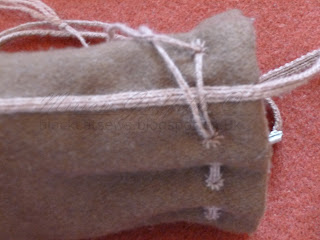I'm obviously on a roll this year - this is my second challenge completed for the year, and we're not even half-way through! Erm, which probably says more about my usual rate of sewing than one cares to...
Anyway, I'm really glad to finish this challenge as a proper women's purse is something I've been missing for the past 10.5 years of re-enactment. It's amazing how much it improves my outfit!
As far as style goes, I went with something similar to this purse from the Luttrell Psalter:
 |
| BL Add. MS 42130, f. 163v. |
Notice how even though she's a lower class woman collecting sheep's milk, her purse still appears to have decorative knots or tassels along the bottom. I went with tassels for mine, based on several extant aumônières (alms purses). I chose a nice chocolate-brown wool for the outer - a colour easily achievable with tannin dyes (which are cheap) and a plain, undyed white wool for the lining.
I also used extant aumônières to judge the size of my purse. In particular, I aimed for about the size of this early 14th Century purse (accession no. 64.101.1364), which is 14 cm x 15.2 cm, and this 14th Century purse (accession no. 27.48.2), which is 15.2 cm x 14.3 cm. For mine, I aimed for 6" tall and 5 1/2" wide, although got maybe 1/4" bigger in each dimension as I forgot to account for the thickness of the fabric.
In terms of pattern, I started with Katafalk's medieval textile belt purse tutorial, although heavily modified it to make it closer to the originals. One design factor I did use of hers was to make the lining fabric slightly smaller than the outer, so that it doesn't show at the mouth of the purse. I also used the construction order she did, although I stitched my purse together rather than doing the braids and the seams in one.
 |
| Nice, neat mouth to the purse. |
For my sides, in line with extant originals, I did a tablet woven edging which extends, forming the hanging cord for the purse. (The tablet weaving actually starts and finishes in the middle of the bottom edge.)
 |
| This is with 4 tablets, alternately threaded SZSZ (or possibly ZSZS ... I can't remember). Each tablet has four threads in and the weft yarn is the same as the warp. |
I also (as you can see in this picture) modified Katafalk's tutorial to have eyelets (like the originals) rather than a drawstring casing. One thing I was quite particular about was to have a sufficient density of eyelets - extant purses tend to have quite densely spaced eyelets whilst most people's reproductions tend only to have about 4 per side. I went with 8 per side, resulting in them being a shade over 1/2" apart.
For the drawstring, I used fingerloop braiding. As my eyelets were quite small, I chose the Open Lace of 5 Bowes, which is found in two 15th Century manuscripts (the Tollemache Book of Secrets and Harleian 2320) as well as a 17th Century manuscript (Serene). It's not documentably 14th Century, but it's as close as I can get.
And, of course, it's not a proper medieval purse without tassels! I went for a conservative three tassels, as this is a lower class purse. I made 4-ply cords from the same yarn I'd used for the tablet weaving, eyelets, fingerloop braids and tassels. I then stitched on and tied off the tassels with this 4-ply cord.
 |
| One nice tassel. Also a good close-up of the tablet weaving. |
So, there we have it. A purse!
What the item is: a belt purse.
The challenge: Circles, squares & rectangles (it's made from two rectangles of fabric).
Fabric/materials: 14 1/2" x 6 1/2" of chocolate-brown wool fabric and 14" x 6 1/2" undyed wool fabric
Pattern: my own riff of Katafalk's medieval textile belt purse tutorial
Year: good for 14th C (personally will use it for c. 1350-70)
Notions: about 1/4 skein of Flinkhand Nm 12/2 naturally dyed (walnut) yarn, a few metres of undyed linen thread, beeswax.
How historically accurate is it? Maybe 75%. Hand sewn with natural fibre fabrics, naturally dyed yarn and broadly correct techniques, but the fabric is synthetically dyed and machine woven and is probably way too nicely finished (i.e. fulled) for a lower class purse.
Hours to complete: maybe 25-30, of which about 1/2 was the tablet weaving and another 2-3 hours was the fingerloop braids (they were looooooong).
First worn: today! (Sat 6th May 2017).
Total cost: to me, nothing - the fabrics were leftovers from other projects and the yarn was a gift. To buy new, you'd have to buy a minimum of 1/2 m of each fabric (so 2x £6-10 ish) plus maybe up to £20 or even £25 for the skein of yarn as it's naturally dyed. Add a couple of £ for some linen thread and maybe 50p for a small block of beeswax. However, you could make maybe 4-6 purses with that amount of material.


No comments:
Post a Comment